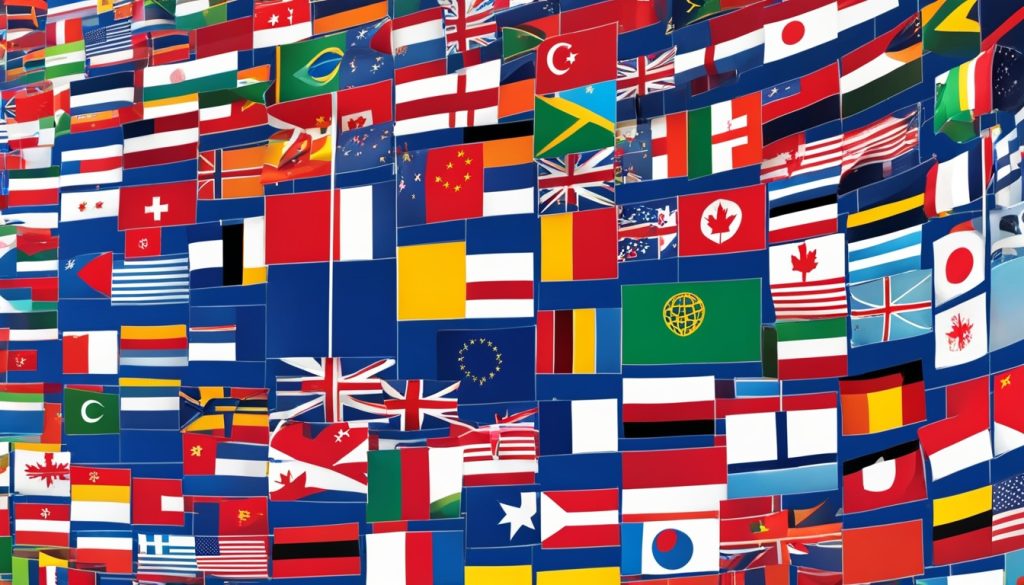Did you know 40% of global shoppers avoid websites not in their own language? This fact highlights the need for a global SEO strategy. It helps businesses grow beyond their borders. Moving into international markets requires a special strategy. It involves cross-border SEO techniques that meet the needs of different areas and languages.
Global SEO is different from the usual. It means getting your site ready for many places. It tells search engines about your international goals. You have to use hreflang tags for targeting by language and country. You also need localised content, smart website setups, and careful URL plans. Knowing how local and international SEO differ, including costs and competition, is crucial. It helps with entering new markets and growing.
A smart international SEO plan boosts your brand’s visibility. It grows your customer base and puts you ahead in the worldwide market.
Key Takeaways
- 40% of global shoppers avoid purchasing from non-native language websites.
- An effective global SEO strategy is key for international market expansion.
- Critical elements are hreflang tags, localised content, and clever URL setups.
- Grasping the differences between local and international SEO is vital for success.
- Good international SEO means more brand exposure and a competitive edge.
Understanding International SEO
International SEO is crucial for a global digital impact. It goes beyond local SEO, including geo-targeting and multilingual approaches. This way, businesses can reach a broader international audience with geographical SEO tactics.
What Makes International SEO Different?
International SEO covers targeting multiple regions and languages, unlike local SEO. It’s about understanding different search engine habits, like using Google in the West and Baidu in China. With multilingual SEO, your website can connect with varied language speakers, broadening your reach.
The Importance of International SEO for Businesses
International SEO is key for companies wanting to grow worldwide. It enhances geographical SEO through specific URL structures and language tags. This improves site visibility and user experience. Targeting an international audience increases market reach and engagement, making content relevant and accessible to different cultures.
Developing an International SEO Strategy

Creating a good international SEO strategy is about knowing and aiming for worldwide markets methodically. To start, find out which countries and languages match your business aims. This helps you to make your site more appealing internationally.
Key Considerations for International SEO
In global SEO, several key points need attention:
- Customer Reviews: Feedback from regional customers boosts local trust and helps with SEO.
- Mobile Responsiveness: Make sure your site works well on mobiles worldwide, enhancing both experience and rankings.
- Google My Business: Use Google My Business for better local search presence globally.
Local vs International SEO: The Main Differences
It’s crucial to understand how local and international SEO differ. Local SEO is about reaching specific areas. Meanwhile, international SEO reaches widely, adapting to various global tastes.
Choosing between focusing on countries or languages affects your content and URLs. Country-based targeting means adjusting both for each nation. Language targeting serves specific language speakers, no matter where they are.
Making the right choices and localising your SEO efforts can lead to big wins globally.
Choosing Target Countries and Languages
Choosing the right countries and languages for your global SEO is key. It helps connect effectively with your desired audience. A smart choice in market selection for SEO boosts visibility and engagement in specific areas. So, how do you decide? It depends on your business goals and where you want to grow.
Country Targeting vs Language Targeting
It’s important to know the difference between country-specific SEO tactics and language targeting for global growth:
- Country Targeting: Perfect for businesses aiming at certain geographic markets. It focuses on optimising for specific countries, considering local search engines and cultural nuances.
- Language Targeting: It aims at reaching a wide audience by focusing on a language, not bound by location. This helps brands grow their market reach globally without geographic limits.
Factors to Consider When Selecting Target Markets
When choosing your markets, consider these important factors:
- Language and Cultural Preferences: Know your potential customers’ language and cultural specifics. This helps with effective international language optimisation and making sure your content clicks with local audiences.
- Search Engine Preferences: Different areas prefer different search engines. For instance, if you’re targeting China, you’ll need to optimise for Baidu, not just Google.
- Market Potential and Risks: Evaluate the potential gains versus the risks of new markets. Careful research helps focus your efforts where they can make the biggest splash.
By mulling over these aspects, companies can build a strong international SEO strategy. This ensures they effectively reach and engage with audiences in new territories.
Optimising Website Structure for International SEO

For a top-notch international site, an easy-to-understand structure is crucial. It should boost the user experience across countries. Also, it must let search engines get the cultural and language differences of your content. Using the right metadata is key to guide search engines and show users the correct content.
Multilingual website design makes navigating your site smooth for all. It uses clear paths that are easy for search engines to follow. This can be by using URLs that are specific to a country or language. The aim is a site that feels local everywhere and guides users with ease.
Using these tips helps give users a great cross-border experience. A well-planned URL setup, with the right tags, helps search engines and users alike. By focusing on these elements, companies can create a strong localised web presence. This makes them stand out in global markets.
Using hreflang Tags Effectively
In the realm of international SEO, hreflang implementation is key. It makes sure users get the right content version for their language and region. This boosts user experience and search ranking.
Implementing hreflang Tags
Proper implementing hreflang tags means adding these marks to each webpage’s HTML. They link to all language and regional versions. This tells search engines about the different versions available. So, users see the content they prefer. For instance, Google uses hreflang tags to find the correct page.
Best Practices for hreflang Tags
To get the most from hreflang tags, following best practices is vital. First, manage multilingual tag management well. Keep a consistent and accurate set of tags throughout your site’s HTML. Also, focus on language-specific SEO strategies. And, know the detailed hreflang annotation best practices well. This avoids content duplication and boosts your international SEO efforts.
Creating Localised Content

Successful international SEO is built on culturally adapted content. It’s about more than just translating words. It’s about understanding how different regions search online and what words they use. This knowledge helps make content that truly connects with people from various cultures and languages.
Understanding Regional Differences in Search Behaviour
Different places have their own ways of searching online, influenced by their culture and language. To appeal to a broad audience, it’s important to dive into these search habits. For example, British and American users might search for the same thing in different ways. Also, using local currencies and measurements can make your content feel more familiar and trustworthy.
Adapting Content for Different Cultures and Languages
SEO localisation is more than translating words. It means creating content in multiple languages that includes local slang, idioms, and cultural references. This shows respect for each culture and improves engagement. Personalising your message for each audience can make your brand more appealing and build loyalty.
Crafting culturally adapted content is a careful process of making multilingual materials. It’s crucial to get the message right and be culturally respectful. Paying close attention to these details can improve your SEO abroad and make your brand more meaningful to everyone.
Implementing Country Code Top-Level Domains (ccTLDs)
Using country code top-level domains (ccTLDs) in your global SEO plan is key for geographic relevance. Domains like .uk for the United Kingdom or .fr for France show your region-targeting to users and search engines. This method boosts trust and confirms your site’s regional authority.
When choosing ccTLDs, it’s important to know how they influence Google and other search engine perceptions. Some ccTLDs are clearly linked to a place (.au for Australia), while others might be more general. This difference can affect your site’s ranking in local search results.
- Geographic Relevance: ccTLDs naturally show where your website focuses, helping search engines match your content with the right area.
- SEO Benefits: Using the right ccTLDs can boost your rankings in a specific country. Search engines usually prefer local content.
- Trust and Conversion: People are more likely to trust and interact with websites that have familiar ccTLDs, increasing conversion chances in those areas.
Adding ccTLDs to your web strategy is crucial. However, it’s vital to understand any potential issues and solutions. Your success will depend on how well you optimise and connect with your target markets.
Utilising Subdomains and Subdirectories for International SEO

Deciding between subdomains and subdirectories is key for a strong international website. Each option offers different SEO benefits. Understanding these can boost your site’s global performance.
Using subdomains means making a unique site for each region, like example.de for Germany or example.fr for France. This setup boosts relevance and improves the experience for local visitors.
On the other hand, subdirectories involve one domain with regional folders. For example, example.com/de/ for Germany and example.com/fr/ for France. This method helps keep the site’s authority unified, aiding SEO and making management easier.
- Subdomains let you tailor content for each market, great for varied audiences.
- Subdirectories can increase your site’s overall authority and its search rankings.
- Your choice should consider how search engines view these structures for targeting and languages.
Choosing the right structure, either subdomains or subdirectories, is crucial. It affects how you reach audiences across the globe. An effective setup ensures you connect with more people efficiently.
Building Local Links for Better SEO
Improving your site’s SEO with local links is key for both local and global markets. Aiming to get more local backlinks or boost local citations for SEO really helps your visibility.
Strategies for Acquiring Local Backlinks
To better your website’s reputation online, try these link-building methods:
- Write guest posts for local blogs.
- Look for sponsored spots in local media.
- Team up with influencers in your area on social media.
- Go to local events and join forums for more backlinks.
These steps help with local backlink acquisition and boosts your SEO in the community. It takes your local reach to a global audience.
Importance of Local Citations
For SEO, local citations are crucial. They confirm your business’s realness and importance in its location. Having your business listed correctly on several platforms increases your trustworthiness with search engines.
- Being on local business directories makes you more visible.
- Make sure your Name, Address, and Phone number are consistent everywhere.
- Connect with local business groups and commerce chambers.
By following these steps, you’ll strengthen your local and global linking strategies. This enhances your digital footprint and drives SEO success.
SEO for International Businesses
International SEO is key for businesses wanting to grow globally. It helps build a strong online presence, leading to more sales and a competitive edge. It’s a game-changer for businesses looking to expand their reach through SEO.
Benefits of International SEO for Business Growth
Stepping into new markets takes more than translating websites. You must get how people search in different areas, aim for local search engines, and make content that fits the culture. This approach brings big rewards:
- Enhanced brand visibility and credibility in international markets
- Increased website traffic from diverse geographic locations
- Higher conversion rates due to targeted, localised content
- Improved competitive positioning in new market segments
Case Studies of Successful International SEO Implementation
Many brands have grown globally by mastering international SEO. These success stories show how effective SEO can spark significant revenue growth:
- Airbnb: Airbnb reached a global audience by tailoring their content for over 60 countries and using geo-targeted SEO strategies. This approach brought them vast digital success worldwide.
- IKEA: IKEA boosted their regional search rankings and built better customer bonds by adapting their site and content for various local markets.
- HSBC: HSBC saw outstanding growth in global markets thanks to their international SEO strategy. This enhanced their online presence in several regions.
These stories highlight international SEO’s role in helping businesses enter new markets and grow globally.
Setting Up Google My Business for International Markets
Setting up Google My Business for international markets boosts your visibility online. This is crucial for appearing in searches across the world. It helps in reaching more people.
When setting this up, it’s vital to be detailed in your information. Make sure you include exact locations you’re targeting. This helps search engines pinpoint your market, improving your online presence.
- Update your business address and operation hours to reflect local time zones.
- Utilise appropriate categories and keywords relevant to each location.
- Encourage local reviews to establish credibility in each market.
Following these steps makes your local listing better in different places. Keeping your business info correct and easy to find is key. By adopting these methods, your business will gain more recognition worldwide and enhance its online presence.
The Role of Social Media in International SEO
In today’s world, social media helps a lot in growing international SEO. Social media does not directly change SEO rankings. But, it makes brands more visible worldwide.
Good social media engagement is key for a strong digital presence internationally. Working with local influencers and sharing content that matters to them builds real connections. This helps gain trust and loyal followers everywhere.
A social media strategy that understands different cultures can make content more engaging for everyone. By posting things that matter to people in different places, companies can reach more people. This helps bring more visitors to their websites and meets international SEO goals.
Even though social media doesn’t directly affect SEO rankings, it’s very important for building a good digital image. Social media is essential for SEO because it helps engage with people meaningfully. This teamwork makes social media very important for international SEO.
Monitoring and Analysing International SEO Performance
Effective international SEO is crucial for businesses looking to stay ahead in many markets. It’s not enough to just launch your site globally. You must check how well it’s doing in different places regularly. Tracking keywords for each area shows if your international SEO plans work well and helps you make smart changes to improve your presence.
Tracking how your site performs across borders involves looking closely at how users interact with it. Seeing how people from different places use your site gives important clues. Checking things like how many pages they view, if they leave quickly, and how long they stay on your site is key. This helps make sure your content stays interesting and relevant to people everywhere, boosting your site’s SEO.
Looking at conversion metrics for your site’s local versions is also essential. Knowing which markets give the best conversion rates can help you use your resources better. You should focus on areas with high growth chances. Keeping your SEO monitoring and analysis methods up to date is key for ongoing success and making the most of global SEO.











